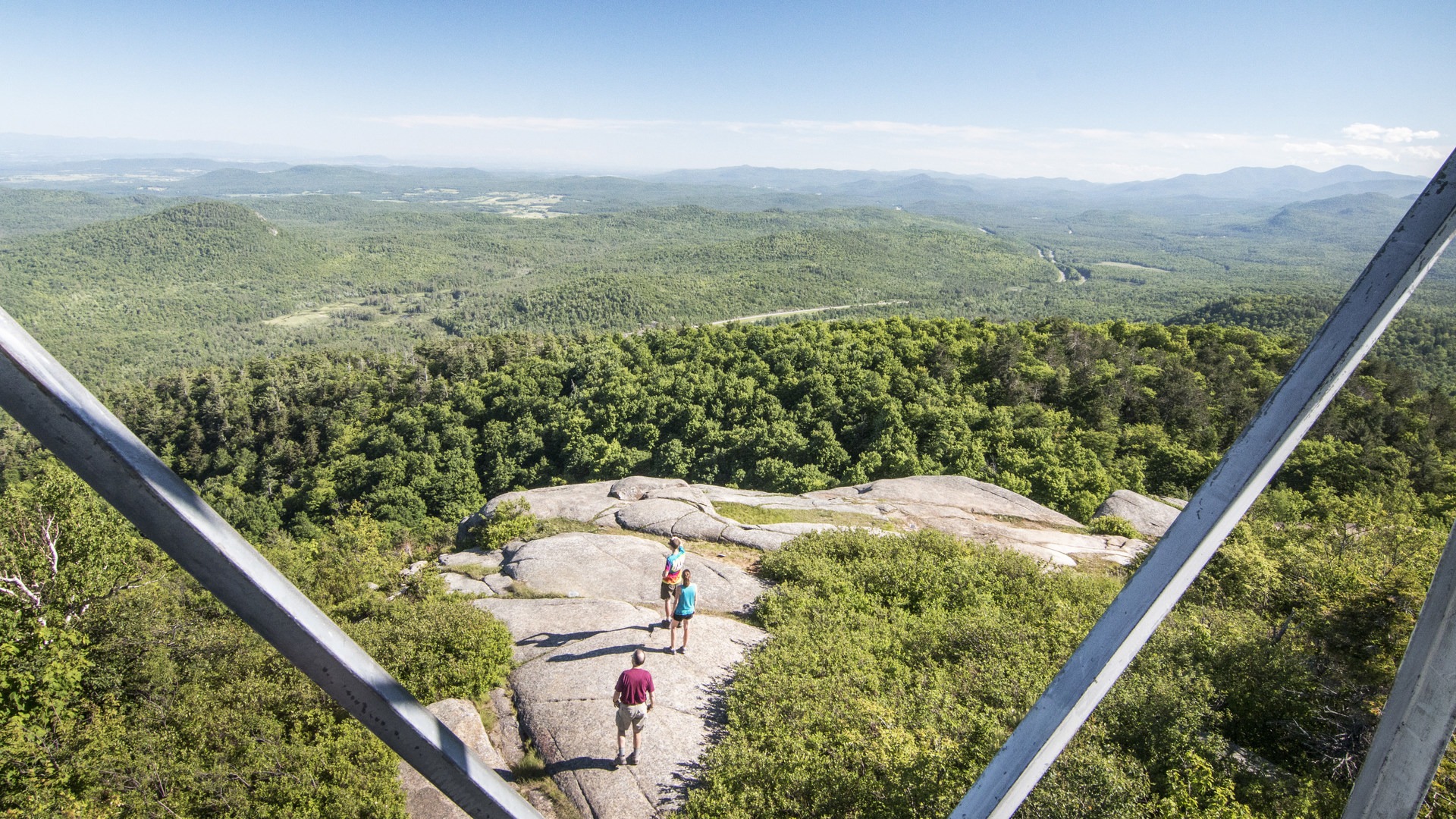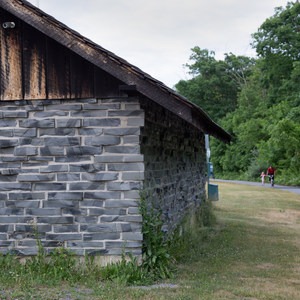You are here
Poke-O-Moonshine Mountain can be recognized by its stunning cliffside that faces the east, a stark contrast to the local landscape. Located in the Taylor Pond Wild Forest, this 2,180-foot mountain is a very popular, highly trafficked destination in the northeastern Adirondacks. There are two trails that lead to the top, and this description follows the Observer’s Trail. It is a 5-mile round-trip route that climbs approximately 1,500 feet to the summit. Atop this momentous peak stands a fire tower with incredible 360-degree views that span from the High Peaks, across Lake Champlain, and to the Green Mountains in Vermont.
The trail begins south of Keeseville on the west side of Route 9. Look for a sign on the road and a small parking area with an information kiosk. A few steps down the trail there is a short bridge over Cold Brook, followed by a registration box. The path turns to the right and begins a gradual ascent up the mountain to the north. As you continue, the route turns into a wider road that was once used by loggers.
This area is part of a 200-acre annexation that was purchased by the Adirondack Land Trust in 2008. About halfway up the mountain you will reach a wide wooden bridge that could very well be submerged in water. A flourishing local beaver community maintains a series of dams here that have flooded this narrow valley and turned it to marshland. This wide opening is scattered with dead trees soaked by these flooded lands. To keep your feet dry, you will have to break off from the identified path. Look to your left, upstream, and you will find an area where others have walked across one of the several dams. But first, don't miss your opportunity to take a good look up to the highest pond area where there is a beaver lodge.
Cross the water and return to the main trail. The route becomes steeper as you gain elevation, and there are many muddy sections with water runoff. The trail will make some wide switchbacks and come to another beaver pond. It almost comes as a surprise to see another constructed marsh this high up, but this particular beaver seems to have selected a very scenic spot backed by the southern wall of the main peak. Another beaver lodge is set out in the middle of the water.
The trail levels out, and you will reach a lean-to. This is at an intersection with the Ranger’s Trail. Turn to the left and follow the red markers past the rock chimney and former ranger’s cabin foundation. The trail narrows, and there is another steep climb ahead that emerges at a small rock outcropping and overlook to the southeast. From here you can clearly see Whiteface Mountain and the faintly lined ski slopes.
The trail continues to meander through the trees and gain more elevation until the fire tower appears before you. Emerge at a clearing with large, natural rock platforms extending to the south. There are beautiful views all around and many places to sit and enjoy the spectacular scene.
Make your way up the platforms of the fire tower to get above the tree line and look out in all directions. The cabin of the fire tower is regularly open in July and August when there is a Tower Steward and Trail Interpreter on duty. To the north is Lyon Mountain, and to the south is Deerfield Mountain with the Jay range behind it. Hurricane, Giant and Gothics can also be seen.
Return on the same path and make note of the right turn at the intersection by the lean-to. The Ranger Trail, which intersects with the path at this point, was the original route up the mountain, but it is currently undergoing various construction and re-routing to update the trail. There are several wooden bridges and many constructed stone stairways with intricate design and rock placement. The Adirondack Mountain Club Trails Program and Tahawus Trails are responsible for the work and are on track to complete the project. Although this path is much steeper than the Observer’s Trail, it has many more viewpoints and lookouts. Unfortunately, some highway sounds will follow you up the mountain if you choose to take it. The starting point for this trail is about half a mile north of the Observer’s Trailhead, so it is possible to do this hike as a loop and trek back on the road if you prefer.
History
The Algonquin Native Americans were among the first people to inhabit this region. They named the mountain “Pohquis Mossie,” which has a rough translation to “place of the broken smooth rocks.” The cliffside created a valley pass from the lake to the mountains, so it was frequently used as a location for trade and diplomatic meetings among tribes.
The first fire tower atop Poke-O-Moonshine was constructed with wood in 1912 as part of the New York State Department of Environmental Conservation’s initiative to monitor and extinguish fire activity throughout the logged mountains in New York State. In 1917, the tower was replaced with a steel Aerometer tower.
In 1940, a guidebook was produced by the Federal Writers’ Project that promoted a local legend about the mountain from the Prohibition era. At that time, it was said that the mountain was a popular place to distill and sell illegal liquor to loggers. Hence, the mountain’s original name became augmented to end with “Moonshine.”
The fire tower was closed in 1988, and the observer’s cabin was burned down three years later, leaving only the fireplace and foundation. There were plans to dismantle the tower in 1995, but like many of the state’s fire towers, a local group formed to preserve and renovate the structure so it could be enjoyed by the public for years to come.
Fire Towers of New York
For almost a century, observers staffed more than 100 fire towers throughout New York State located primarily on the highest peaks in the Catskill and Adirondack regions. This was in response to the intense logging and tannin harvesting operations that would leave virgin forest barren, dried, and very susceptible to fire. Rangers would often reside in nearby cabins while keeping a regular lookout for smoke and flames throughout the surrounding valleys. If a fire was spotted, a message was sent to the nearby town, and the location of the suspected fire would be triangulated and confirmed by other fire towers in the area.
Beginning in the 1980s the towers were systematically closed as monitoring from planes became more cost effective. Some towers have been dismantled, others remain in disrepair, while a select few have been revitalized by the DEC or purchased and renovated by the general public. Restorations continue throughout the state, and there are many assistance programs you can join to help support and maintain these historic icons. Each tower offers a new and unique perspective of New York and serves as a monument to forest protection throughout the state. Challenge yourself to visit them all!








Comments
Sign In and share them.